Authentic Leadership, Leader-Member Exchange and PsyCap Building
VerifiedAdded on 2023/06/09
|12
|2516
|132
Essay
AI Summary
This essay examines the impact of authentic leadership (AL) on employee psychological capital (PsyCap) and the role of leader-member exchange (LMX). It highlights how authentic leaders, characterized by transparency, ethical practices, and a focus on organizational goals, foster a positive work environment that enhances employee job satisfaction and reduces job insecurity. The essay discusses the LMX theory, emphasizing the importance of trust and respect in leader-follower relationships, and its three phases: role-taking, role-making, and routinization. Furthermore, it explores the four components of PsyCap—self-efficacy, hope, optimism, and resilience—and how authentic leadership contributes to building these positive psychological resources among diverse employee groups. The essay also addresses the impact of emotions on employee performance, underscoring the need for leaders to cultivate a supportive environment that promotes positive emotions and mitigates negative ones, ultimately leading to improved organizational outcomes. This document is available on Desklib, a platform offering a wealth of academic resources for students.
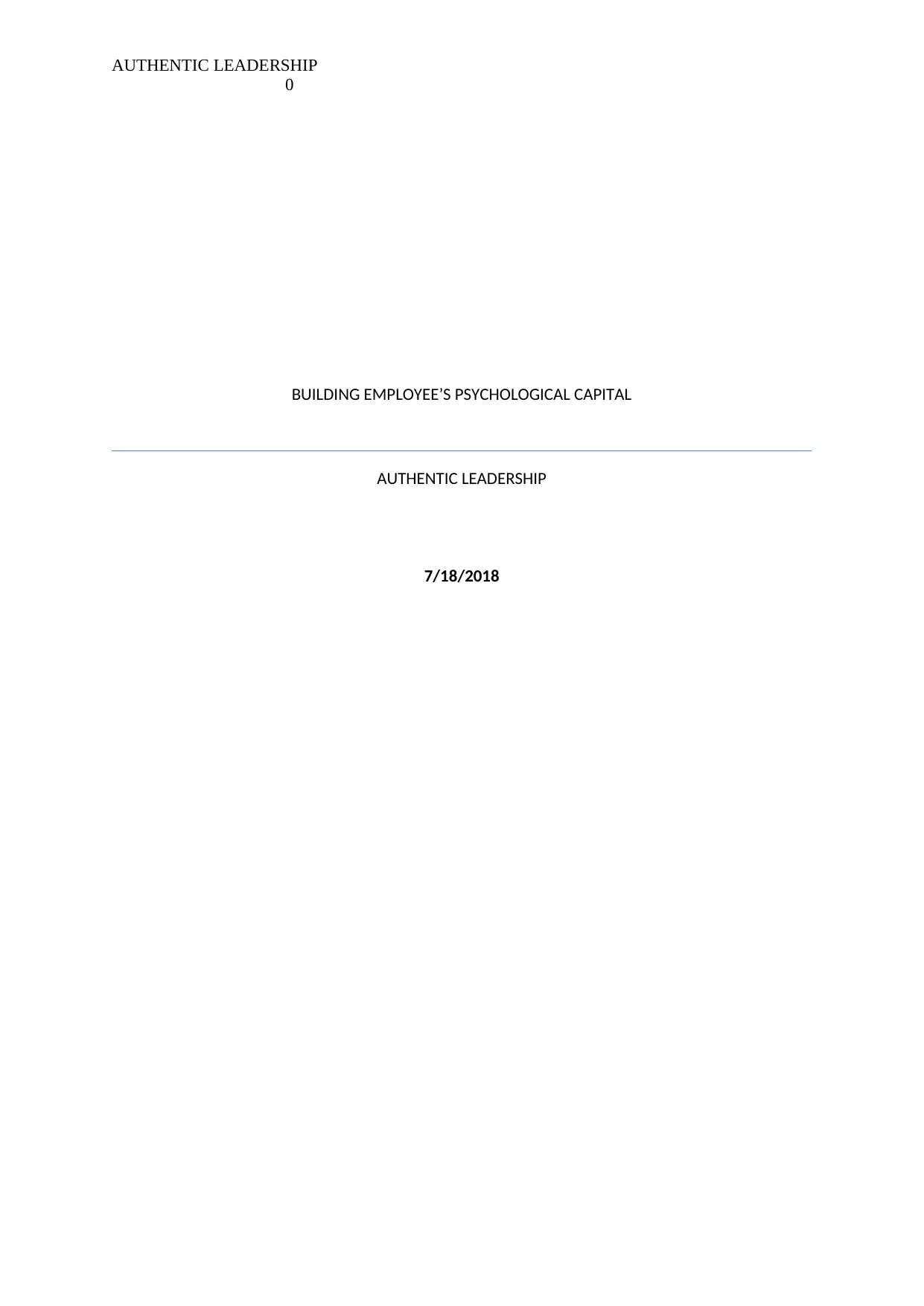
AUTHENTIC LEADERSHIP
0
BUILDING EMPLOYEE’S PSYCHOLOGICAL CAPITAL
AUTHENTIC LEADERSHIP
7/18/2018
0
BUILDING EMPLOYEE’S PSYCHOLOGICAL CAPITAL
AUTHENTIC LEADERSHIP
7/18/2018
Paraphrase This Document
Need a fresh take? Get an instant paraphrase of this document with our AI Paraphraser
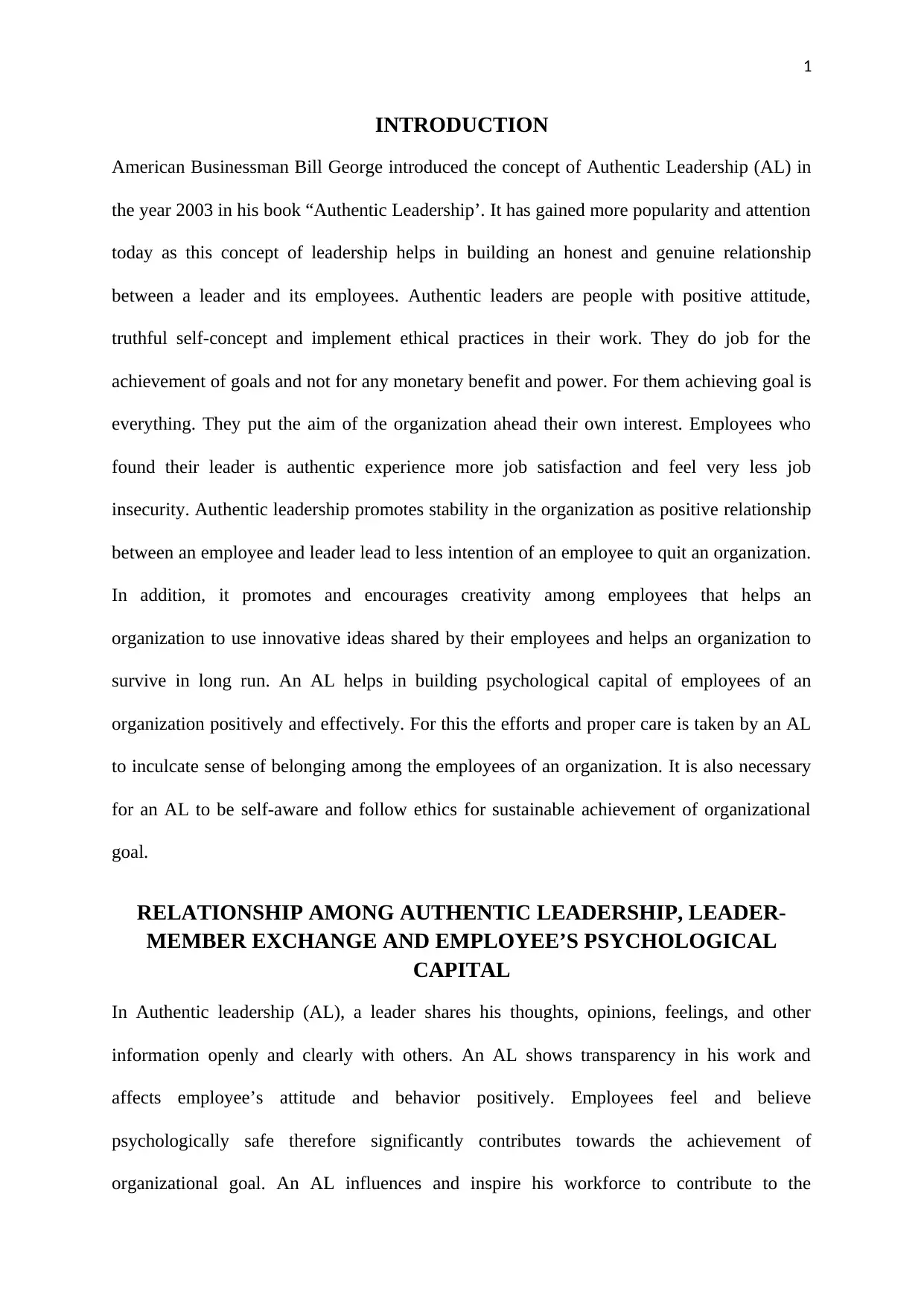
1
INTRODUCTION
American Businessman Bill George introduced the concept of Authentic Leadership (AL) in
the year 2003 in his book “Authentic Leadership’. It has gained more popularity and attention
today as this concept of leadership helps in building an honest and genuine relationship
between a leader and its employees. Authentic leaders are people with positive attitude,
truthful self-concept and implement ethical practices in their work. They do job for the
achievement of goals and not for any monetary benefit and power. For them achieving goal is
everything. They put the aim of the organization ahead their own interest. Employees who
found their leader is authentic experience more job satisfaction and feel very less job
insecurity. Authentic leadership promotes stability in the organization as positive relationship
between an employee and leader lead to less intention of an employee to quit an organization.
In addition, it promotes and encourages creativity among employees that helps an
organization to use innovative ideas shared by their employees and helps an organization to
survive in long run. An AL helps in building psychological capital of employees of an
organization positively and effectively. For this the efforts and proper care is taken by an AL
to inculcate sense of belonging among the employees of an organization. It is also necessary
for an AL to be self-aware and follow ethics for sustainable achievement of organizational
goal.
RELATIONSHIP AMONG AUTHENTIC LEADERSHIP, LEADER-
MEMBER EXCHANGE AND EMPLOYEE’S PSYCHOLOGICAL
CAPITAL
In Authentic leadership (AL), a leader shares his thoughts, opinions, feelings, and other
information openly and clearly with others. An AL shows transparency in his work and
affects employee’s attitude and behavior positively. Employees feel and believe
psychologically safe therefore significantly contributes towards the achievement of
organizational goal. An AL influences and inspire his workforce to contribute to the
INTRODUCTION
American Businessman Bill George introduced the concept of Authentic Leadership (AL) in
the year 2003 in his book “Authentic Leadership’. It has gained more popularity and attention
today as this concept of leadership helps in building an honest and genuine relationship
between a leader and its employees. Authentic leaders are people with positive attitude,
truthful self-concept and implement ethical practices in their work. They do job for the
achievement of goals and not for any monetary benefit and power. For them achieving goal is
everything. They put the aim of the organization ahead their own interest. Employees who
found their leader is authentic experience more job satisfaction and feel very less job
insecurity. Authentic leadership promotes stability in the organization as positive relationship
between an employee and leader lead to less intention of an employee to quit an organization.
In addition, it promotes and encourages creativity among employees that helps an
organization to use innovative ideas shared by their employees and helps an organization to
survive in long run. An AL helps in building psychological capital of employees of an
organization positively and effectively. For this the efforts and proper care is taken by an AL
to inculcate sense of belonging among the employees of an organization. It is also necessary
for an AL to be self-aware and follow ethics for sustainable achievement of organizational
goal.
RELATIONSHIP AMONG AUTHENTIC LEADERSHIP, LEADER-
MEMBER EXCHANGE AND EMPLOYEE’S PSYCHOLOGICAL
CAPITAL
In Authentic leadership (AL), a leader shares his thoughts, opinions, feelings, and other
information openly and clearly with others. An AL shows transparency in his work and
affects employee’s attitude and behavior positively. Employees feel and believe
psychologically safe therefore significantly contributes towards the achievement of
organizational goal. An AL influences and inspire his workforce to contribute to the

2
organizations goal with full zeal and enthusiasm. Any relationship in this world is based on
trust and respect. One of the exceptional and practical theory of leadership Leader member
exchange (LMX) theory is also known as Vertical Dyad Linkage theory. Leader member
exchange is an interactive relationship between a leader and his followers. This theory deals
with how a leader develops relationship with its team members and whether these
relationship can significantly contribute to the growth or not. The relationship quality can be
assessed by measuring the degree of trust, understanding, cohesion and support of leaders and
members. A leader in a group maintains his position via exchange agreement with its fellow
members. An AL helps in improving leader-member exchange quality and therefore gaining
trust and confidence of employees. The theory of leader member exchange focuses on the
fact that people are different and they need an interaction. In the year 1987 it was being
suggested by Grean and Scandura that the LMX theory of development goes through three
phases. The theory focuses that relationship between a leader and his subordinates go through
three phases. They are role taking, role making, and routinization.
Role taking
It takes place when a team member joins a group. Then leader of the group measure and
evaluate the skills of the new member and provides them with an opportunity to display their
capabilities and capacities.
Role making
In this process, new team members start working on a project assigned to them. It is generally
expected by a leader that new members will perform their duties and tasks assigned to them
with full honesty, sincerity, dedication, and diligence. Building trust is really important in
role making process if a leader feel betrayed then this can lead to demotion of the member
out -group. During this phase a leader, divide new members into two groups:
organizations goal with full zeal and enthusiasm. Any relationship in this world is based on
trust and respect. One of the exceptional and practical theory of leadership Leader member
exchange (LMX) theory is also known as Vertical Dyad Linkage theory. Leader member
exchange is an interactive relationship between a leader and his followers. This theory deals
with how a leader develops relationship with its team members and whether these
relationship can significantly contribute to the growth or not. The relationship quality can be
assessed by measuring the degree of trust, understanding, cohesion and support of leaders and
members. A leader in a group maintains his position via exchange agreement with its fellow
members. An AL helps in improving leader-member exchange quality and therefore gaining
trust and confidence of employees. The theory of leader member exchange focuses on the
fact that people are different and they need an interaction. In the year 1987 it was being
suggested by Grean and Scandura that the LMX theory of development goes through three
phases. The theory focuses that relationship between a leader and his subordinates go through
three phases. They are role taking, role making, and routinization.
Role taking
It takes place when a team member joins a group. Then leader of the group measure and
evaluate the skills of the new member and provides them with an opportunity to display their
capabilities and capacities.
Role making
In this process, new team members start working on a project assigned to them. It is generally
expected by a leader that new members will perform their duties and tasks assigned to them
with full honesty, sincerity, dedication, and diligence. Building trust is really important in
role making process if a leader feel betrayed then this can lead to demotion of the member
out -group. During this phase a leader, divide new members into two groups:
⊘ This is a preview!⊘
Do you want full access?
Subscribe today to unlock all pages.

Trusted by 1+ million students worldwide
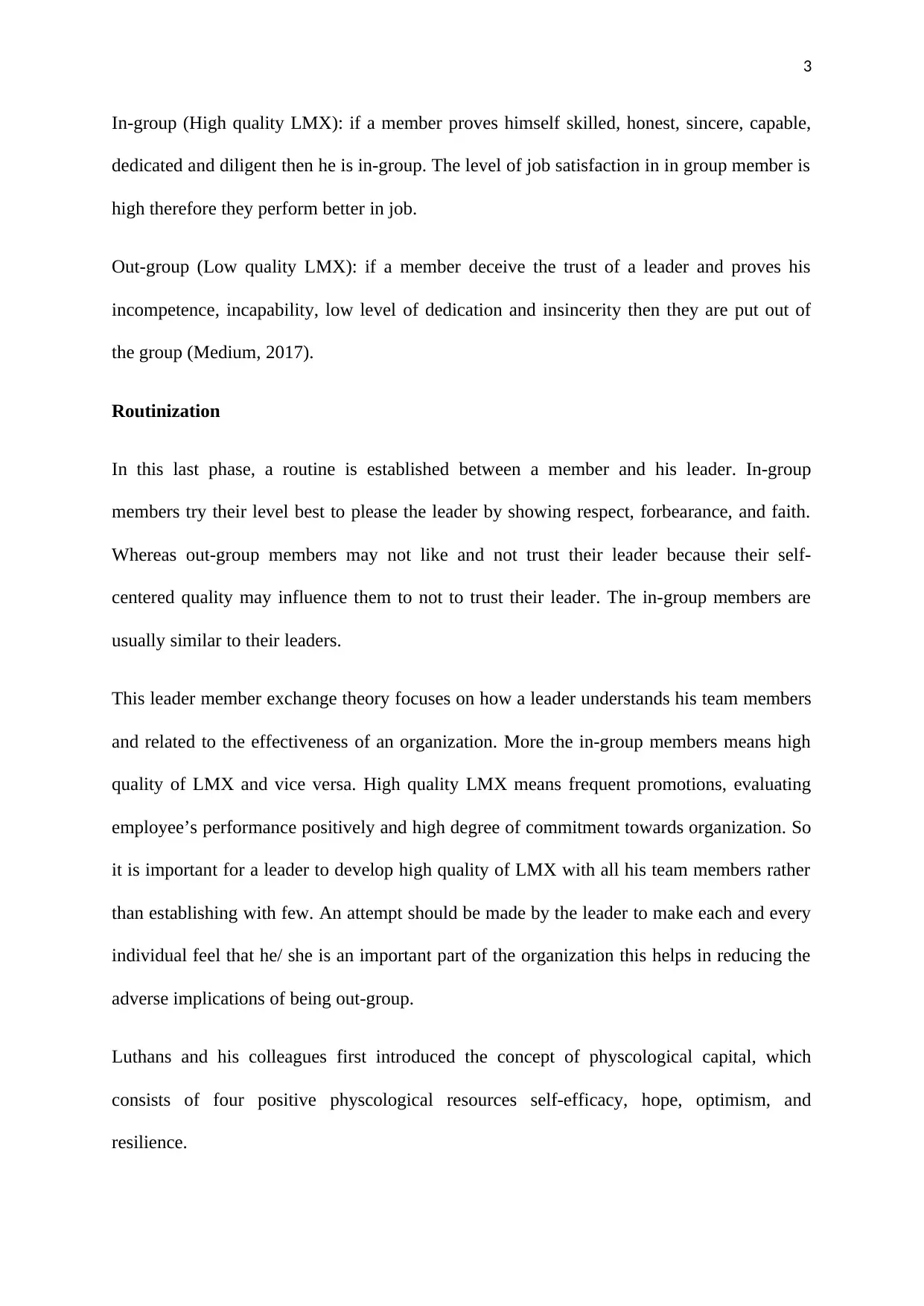
3
In-group (High quality LMX): if a member proves himself skilled, honest, sincere, capable,
dedicated and diligent then he is in-group. The level of job satisfaction in in group member is
high therefore they perform better in job.
Out-group (Low quality LMX): if a member deceive the trust of a leader and proves his
incompetence, incapability, low level of dedication and insincerity then they are put out of
the group (Medium, 2017).
Routinization
In this last phase, a routine is established between a member and his leader. In-group
members try their level best to please the leader by showing respect, forbearance, and faith.
Whereas out-group members may not like and not trust their leader because their self-
centered quality may influence them to not to trust their leader. The in-group members are
usually similar to their leaders.
This leader member exchange theory focuses on how a leader understands his team members
and related to the effectiveness of an organization. More the in-group members means high
quality of LMX and vice versa. High quality LMX means frequent promotions, evaluating
employee’s performance positively and high degree of commitment towards organization. So
it is important for a leader to develop high quality of LMX with all his team members rather
than establishing with few. An attempt should be made by the leader to make each and every
individual feel that he/ she is an important part of the organization this helps in reducing the
adverse implications of being out-group.
Luthans and his colleagues first introduced the concept of physcological capital, which
consists of four positive physcological resources self-efficacy, hope, optimism, and
resilience.
In-group (High quality LMX): if a member proves himself skilled, honest, sincere, capable,
dedicated and diligent then he is in-group. The level of job satisfaction in in group member is
high therefore they perform better in job.
Out-group (Low quality LMX): if a member deceive the trust of a leader and proves his
incompetence, incapability, low level of dedication and insincerity then they are put out of
the group (Medium, 2017).
Routinization
In this last phase, a routine is established between a member and his leader. In-group
members try their level best to please the leader by showing respect, forbearance, and faith.
Whereas out-group members may not like and not trust their leader because their self-
centered quality may influence them to not to trust their leader. The in-group members are
usually similar to their leaders.
This leader member exchange theory focuses on how a leader understands his team members
and related to the effectiveness of an organization. More the in-group members means high
quality of LMX and vice versa. High quality LMX means frequent promotions, evaluating
employee’s performance positively and high degree of commitment towards organization. So
it is important for a leader to develop high quality of LMX with all his team members rather
than establishing with few. An attempt should be made by the leader to make each and every
individual feel that he/ she is an important part of the organization this helps in reducing the
adverse implications of being out-group.
Luthans and his colleagues first introduced the concept of physcological capital, which
consists of four positive physcological resources self-efficacy, hope, optimism, and
resilience.
Paraphrase This Document
Need a fresh take? Get an instant paraphrase of this document with our AI Paraphraser
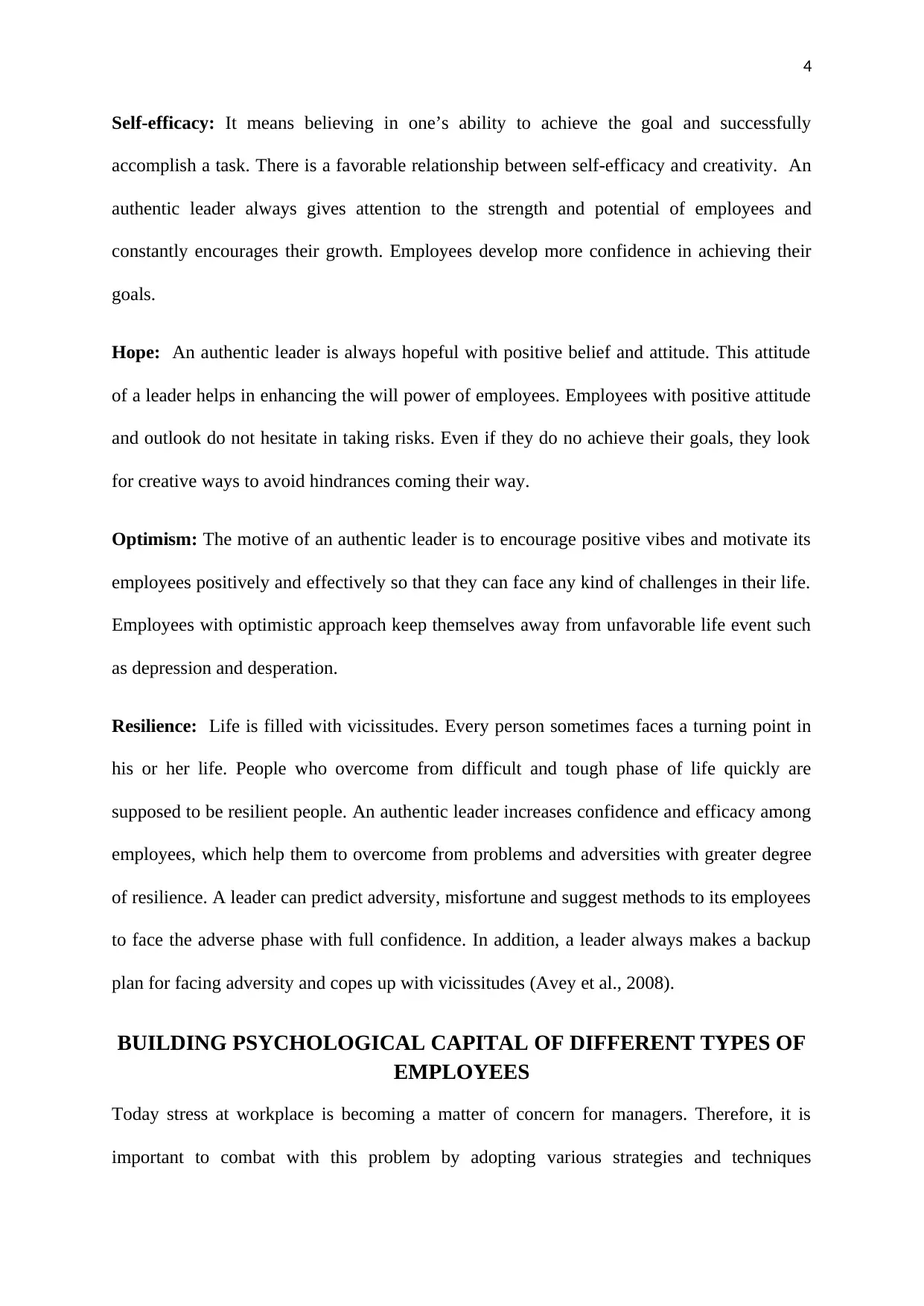
4
Self-efficacy: It means believing in one’s ability to achieve the goal and successfully
accomplish a task. There is a favorable relationship between self-efficacy and creativity. An
authentic leader always gives attention to the strength and potential of employees and
constantly encourages their growth. Employees develop more confidence in achieving their
goals.
Hope: An authentic leader is always hopeful with positive belief and attitude. This attitude
of a leader helps in enhancing the will power of employees. Employees with positive attitude
and outlook do not hesitate in taking risks. Even if they do no achieve their goals, they look
for creative ways to avoid hindrances coming their way.
Optimism: The motive of an authentic leader is to encourage positive vibes and motivate its
employees positively and effectively so that they can face any kind of challenges in their life.
Employees with optimistic approach keep themselves away from unfavorable life event such
as depression and desperation.
Resilience: Life is filled with vicissitudes. Every person sometimes faces a turning point in
his or her life. People who overcome from difficult and tough phase of life quickly are
supposed to be resilient people. An authentic leader increases confidence and efficacy among
employees, which help them to overcome from problems and adversities with greater degree
of resilience. A leader can predict adversity, misfortune and suggest methods to its employees
to face the adverse phase with full confidence. In addition, a leader always makes a backup
plan for facing adversity and copes up with vicissitudes (Avey et al., 2008).
BUILDING PSYCHOLOGICAL CAPITAL OF DIFFERENT TYPES OF
EMPLOYEES
Today stress at workplace is becoming a matter of concern for managers. Therefore, it is
important to combat with this problem by adopting various strategies and techniques
Self-efficacy: It means believing in one’s ability to achieve the goal and successfully
accomplish a task. There is a favorable relationship between self-efficacy and creativity. An
authentic leader always gives attention to the strength and potential of employees and
constantly encourages their growth. Employees develop more confidence in achieving their
goals.
Hope: An authentic leader is always hopeful with positive belief and attitude. This attitude
of a leader helps in enhancing the will power of employees. Employees with positive attitude
and outlook do not hesitate in taking risks. Even if they do no achieve their goals, they look
for creative ways to avoid hindrances coming their way.
Optimism: The motive of an authentic leader is to encourage positive vibes and motivate its
employees positively and effectively so that they can face any kind of challenges in their life.
Employees with optimistic approach keep themselves away from unfavorable life event such
as depression and desperation.
Resilience: Life is filled with vicissitudes. Every person sometimes faces a turning point in
his or her life. People who overcome from difficult and tough phase of life quickly are
supposed to be resilient people. An authentic leader increases confidence and efficacy among
employees, which help them to overcome from problems and adversities with greater degree
of resilience. A leader can predict adversity, misfortune and suggest methods to its employees
to face the adverse phase with full confidence. In addition, a leader always makes a backup
plan for facing adversity and copes up with vicissitudes (Avey et al., 2008).
BUILDING PSYCHOLOGICAL CAPITAL OF DIFFERENT TYPES OF
EMPLOYEES
Today stress at workplace is becoming a matter of concern for managers. Therefore, it is
important to combat with this problem by adopting various strategies and techniques
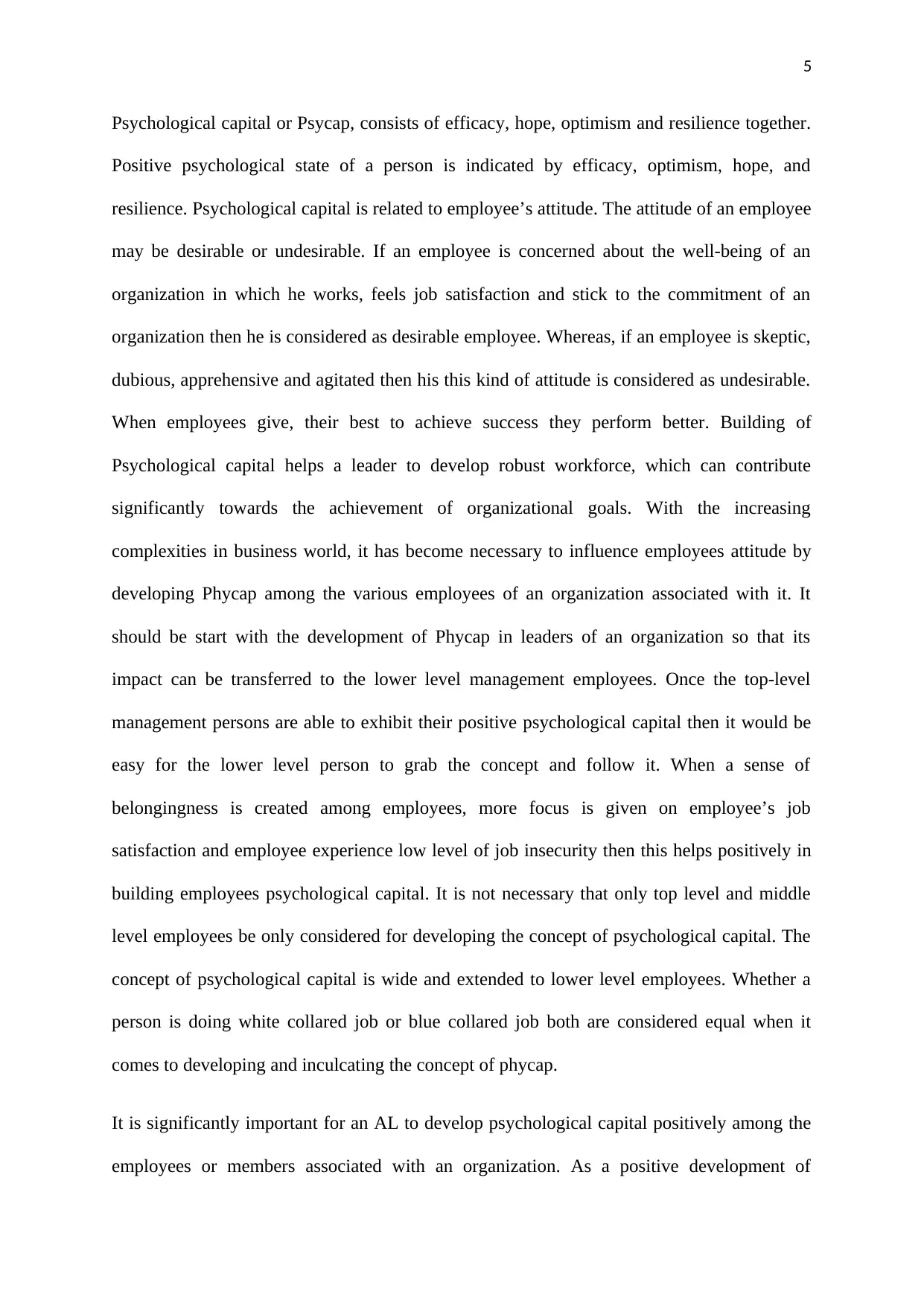
5
Psychological capital or Psycap, consists of efficacy, hope, optimism and resilience together.
Positive psychological state of a person is indicated by efficacy, optimism, hope, and
resilience. Psychological capital is related to employee’s attitude. The attitude of an employee
may be desirable or undesirable. If an employee is concerned about the well-being of an
organization in which he works, feels job satisfaction and stick to the commitment of an
organization then he is considered as desirable employee. Whereas, if an employee is skeptic,
dubious, apprehensive and agitated then his this kind of attitude is considered as undesirable.
When employees give, their best to achieve success they perform better. Building of
Psychological capital helps a leader to develop robust workforce, which can contribute
significantly towards the achievement of organizational goals. With the increasing
complexities in business world, it has become necessary to influence employees attitude by
developing Phycap among the various employees of an organization associated with it. It
should be start with the development of Phycap in leaders of an organization so that its
impact can be transferred to the lower level management employees. Once the top-level
management persons are able to exhibit their positive psychological capital then it would be
easy for the lower level person to grab the concept and follow it. When a sense of
belongingness is created among employees, more focus is given on employee’s job
satisfaction and employee experience low level of job insecurity then this helps positively in
building employees psychological capital. It is not necessary that only top level and middle
level employees be only considered for developing the concept of psychological capital. The
concept of psychological capital is wide and extended to lower level employees. Whether a
person is doing white collared job or blue collared job both are considered equal when it
comes to developing and inculcating the concept of phycap.
It is significantly important for an AL to develop psychological capital positively among the
employees or members associated with an organization. As a positive development of
Psychological capital or Psycap, consists of efficacy, hope, optimism and resilience together.
Positive psychological state of a person is indicated by efficacy, optimism, hope, and
resilience. Psychological capital is related to employee’s attitude. The attitude of an employee
may be desirable or undesirable. If an employee is concerned about the well-being of an
organization in which he works, feels job satisfaction and stick to the commitment of an
organization then he is considered as desirable employee. Whereas, if an employee is skeptic,
dubious, apprehensive and agitated then his this kind of attitude is considered as undesirable.
When employees give, their best to achieve success they perform better. Building of
Psychological capital helps a leader to develop robust workforce, which can contribute
significantly towards the achievement of organizational goals. With the increasing
complexities in business world, it has become necessary to influence employees attitude by
developing Phycap among the various employees of an organization associated with it. It
should be start with the development of Phycap in leaders of an organization so that its
impact can be transferred to the lower level management employees. Once the top-level
management persons are able to exhibit their positive psychological capital then it would be
easy for the lower level person to grab the concept and follow it. When a sense of
belongingness is created among employees, more focus is given on employee’s job
satisfaction and employee experience low level of job insecurity then this helps positively in
building employees psychological capital. It is not necessary that only top level and middle
level employees be only considered for developing the concept of psychological capital. The
concept of psychological capital is wide and extended to lower level employees. Whether a
person is doing white collared job or blue collared job both are considered equal when it
comes to developing and inculcating the concept of phycap.
It is significantly important for an AL to develop psychological capital positively among the
employees or members associated with an organization. As a positive development of
⊘ This is a preview!⊘
Do you want full access?
Subscribe today to unlock all pages.

Trusted by 1+ million students worldwide
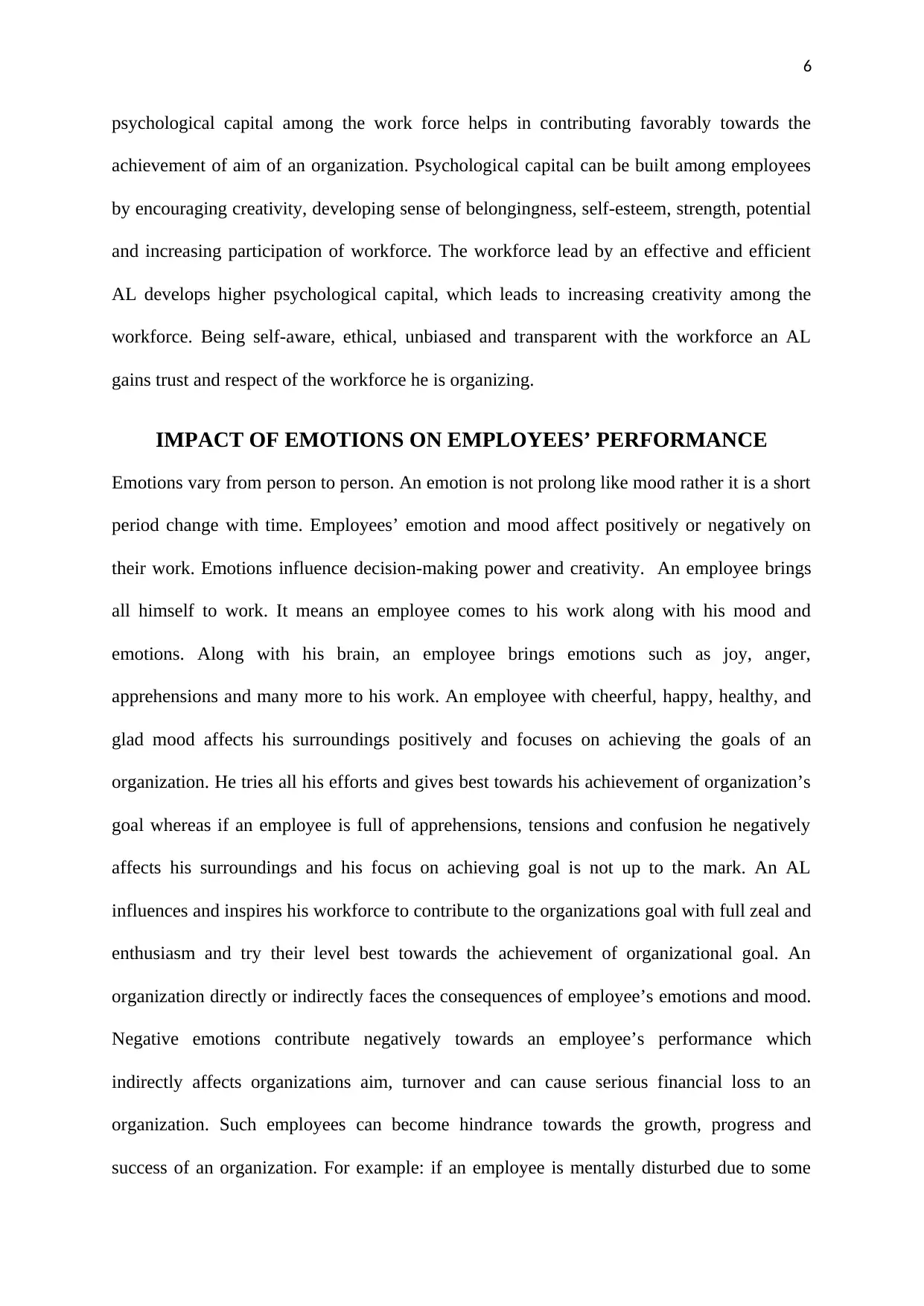
6
psychological capital among the work force helps in contributing favorably towards the
achievement of aim of an organization. Psychological capital can be built among employees
by encouraging creativity, developing sense of belongingness, self-esteem, strength, potential
and increasing participation of workforce. The workforce lead by an effective and efficient
AL develops higher psychological capital, which leads to increasing creativity among the
workforce. Being self-aware, ethical, unbiased and transparent with the workforce an AL
gains trust and respect of the workforce he is organizing.
IMPACT OF EMOTIONS ON EMPLOYEES’ PERFORMANCE
Emotions vary from person to person. An emotion is not prolong like mood rather it is a short
period change with time. Employees’ emotion and mood affect positively or negatively on
their work. Emotions influence decision-making power and creativity. An employee brings
all himself to work. It means an employee comes to his work along with his mood and
emotions. Along with his brain, an employee brings emotions such as joy, anger,
apprehensions and many more to his work. An employee with cheerful, happy, healthy, and
glad mood affects his surroundings positively and focuses on achieving the goals of an
organization. He tries all his efforts and gives best towards his achievement of organization’s
goal whereas if an employee is full of apprehensions, tensions and confusion he negatively
affects his surroundings and his focus on achieving goal is not up to the mark. An AL
influences and inspires his workforce to contribute to the organizations goal with full zeal and
enthusiasm and try their level best towards the achievement of organizational goal. An
organization directly or indirectly faces the consequences of employee’s emotions and mood.
Negative emotions contribute negatively towards an employee’s performance which
indirectly affects organizations aim, turnover and can cause serious financial loss to an
organization. Such employees can become hindrance towards the growth, progress and
success of an organization. For example: if an employee is mentally disturbed due to some
psychological capital among the work force helps in contributing favorably towards the
achievement of aim of an organization. Psychological capital can be built among employees
by encouraging creativity, developing sense of belongingness, self-esteem, strength, potential
and increasing participation of workforce. The workforce lead by an effective and efficient
AL develops higher psychological capital, which leads to increasing creativity among the
workforce. Being self-aware, ethical, unbiased and transparent with the workforce an AL
gains trust and respect of the workforce he is organizing.
IMPACT OF EMOTIONS ON EMPLOYEES’ PERFORMANCE
Emotions vary from person to person. An emotion is not prolong like mood rather it is a short
period change with time. Employees’ emotion and mood affect positively or negatively on
their work. Emotions influence decision-making power and creativity. An employee brings
all himself to work. It means an employee comes to his work along with his mood and
emotions. Along with his brain, an employee brings emotions such as joy, anger,
apprehensions and many more to his work. An employee with cheerful, happy, healthy, and
glad mood affects his surroundings positively and focuses on achieving the goals of an
organization. He tries all his efforts and gives best towards his achievement of organization’s
goal whereas if an employee is full of apprehensions, tensions and confusion he negatively
affects his surroundings and his focus on achieving goal is not up to the mark. An AL
influences and inspires his workforce to contribute to the organizations goal with full zeal and
enthusiasm and try their level best towards the achievement of organizational goal. An
organization directly or indirectly faces the consequences of employee’s emotions and mood.
Negative emotions contribute negatively towards an employee’s performance which
indirectly affects organizations aim, turnover and can cause serious financial loss to an
organization. Such employees can become hindrance towards the growth, progress and
success of an organization. For example: if an employee is mentally disturbed due to some
Paraphrase This Document
Need a fresh take? Get an instant paraphrase of this document with our AI Paraphraser
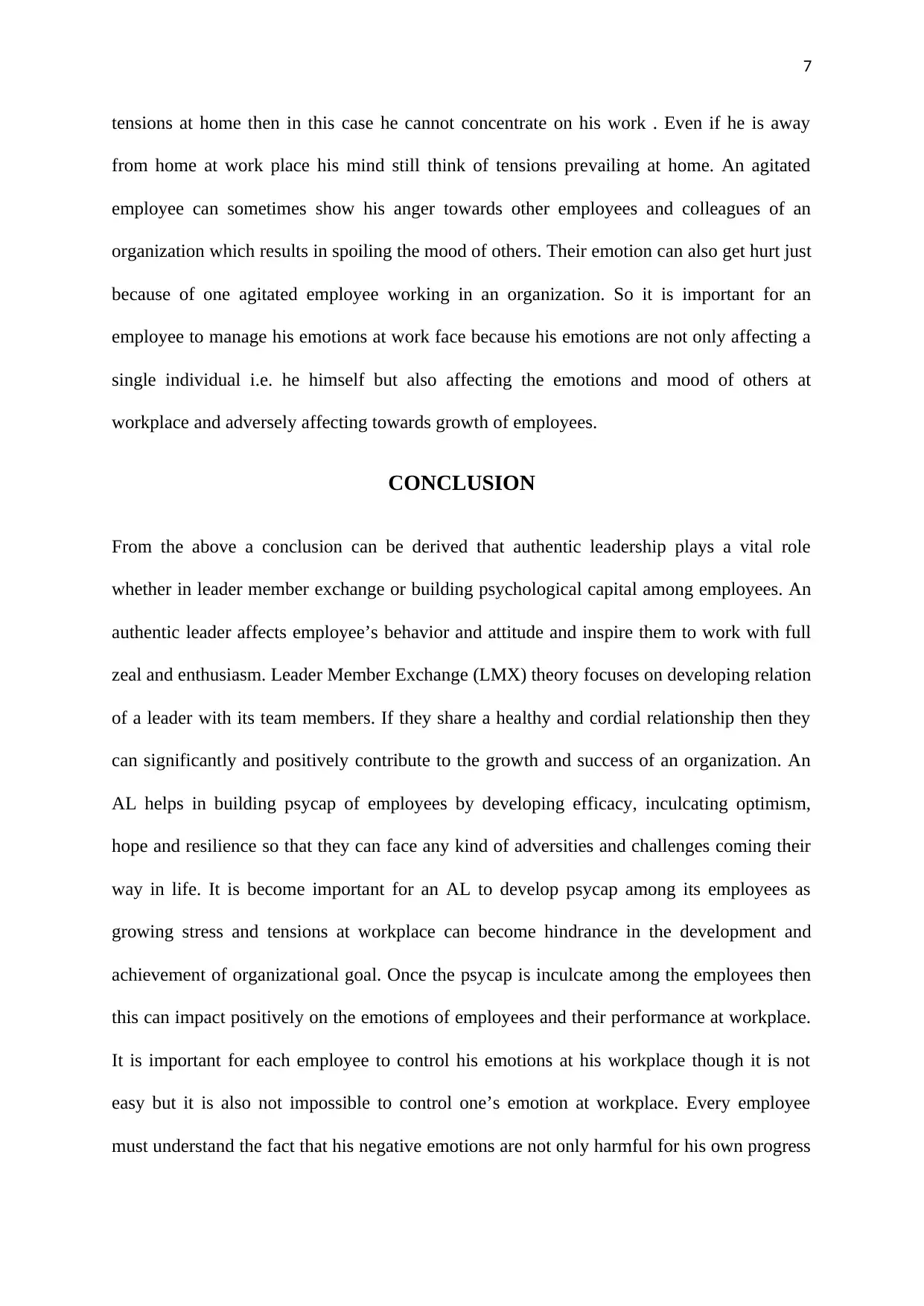
7
tensions at home then in this case he cannot concentrate on his work . Even if he is away
from home at work place his mind still think of tensions prevailing at home. An agitated
employee can sometimes show his anger towards other employees and colleagues of an
organization which results in spoiling the mood of others. Their emotion can also get hurt just
because of one agitated employee working in an organization. So it is important for an
employee to manage his emotions at work face because his emotions are not only affecting a
single individual i.e. he himself but also affecting the emotions and mood of others at
workplace and adversely affecting towards growth of employees.
CONCLUSION
From the above a conclusion can be derived that authentic leadership plays a vital role
whether in leader member exchange or building psychological capital among employees. An
authentic leader affects employee’s behavior and attitude and inspire them to work with full
zeal and enthusiasm. Leader Member Exchange (LMX) theory focuses on developing relation
of a leader with its team members. If they share a healthy and cordial relationship then they
can significantly and positively contribute to the growth and success of an organization. An
AL helps in building psycap of employees by developing efficacy, inculcating optimism,
hope and resilience so that they can face any kind of adversities and challenges coming their
way in life. It is become important for an AL to develop psycap among its employees as
growing stress and tensions at workplace can become hindrance in the development and
achievement of organizational goal. Once the psycap is inculcate among the employees then
this can impact positively on the emotions of employees and their performance at workplace.
It is important for each employee to control his emotions at his workplace though it is not
easy but it is also not impossible to control one’s emotion at workplace. Every employee
must understand the fact that his negative emotions are not only harmful for his own progress
tensions at home then in this case he cannot concentrate on his work . Even if he is away
from home at work place his mind still think of tensions prevailing at home. An agitated
employee can sometimes show his anger towards other employees and colleagues of an
organization which results in spoiling the mood of others. Their emotion can also get hurt just
because of one agitated employee working in an organization. So it is important for an
employee to manage his emotions at work face because his emotions are not only affecting a
single individual i.e. he himself but also affecting the emotions and mood of others at
workplace and adversely affecting towards growth of employees.
CONCLUSION
From the above a conclusion can be derived that authentic leadership plays a vital role
whether in leader member exchange or building psychological capital among employees. An
authentic leader affects employee’s behavior and attitude and inspire them to work with full
zeal and enthusiasm. Leader Member Exchange (LMX) theory focuses on developing relation
of a leader with its team members. If they share a healthy and cordial relationship then they
can significantly and positively contribute to the growth and success of an organization. An
AL helps in building psycap of employees by developing efficacy, inculcating optimism,
hope and resilience so that they can face any kind of adversities and challenges coming their
way in life. It is become important for an AL to develop psycap among its employees as
growing stress and tensions at workplace can become hindrance in the development and
achievement of organizational goal. Once the psycap is inculcate among the employees then
this can impact positively on the emotions of employees and their performance at workplace.
It is important for each employee to control his emotions at his workplace though it is not
easy but it is also not impossible to control one’s emotion at workplace. Every employee
must understand the fact that his negative emotions are not only harmful for his own progress
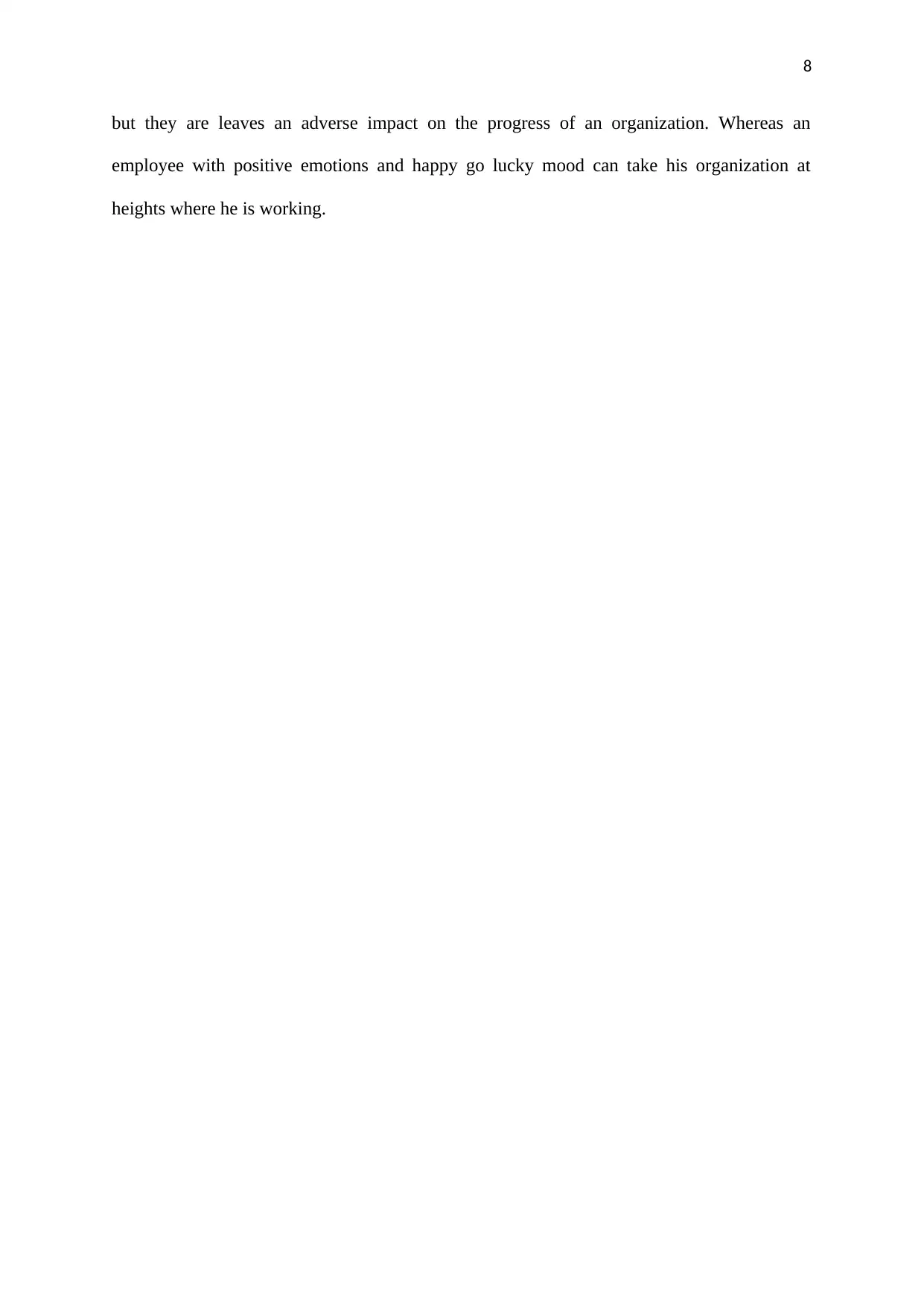
8
but they are leaves an adverse impact on the progress of an organization. Whereas an
employee with positive emotions and happy go lucky mood can take his organization at
heights where he is working.
but they are leaves an adverse impact on the progress of an organization. Whereas an
employee with positive emotions and happy go lucky mood can take his organization at
heights where he is working.
⊘ This is a preview!⊘
Do you want full access?
Subscribe today to unlock all pages.

Trusted by 1+ million students worldwide
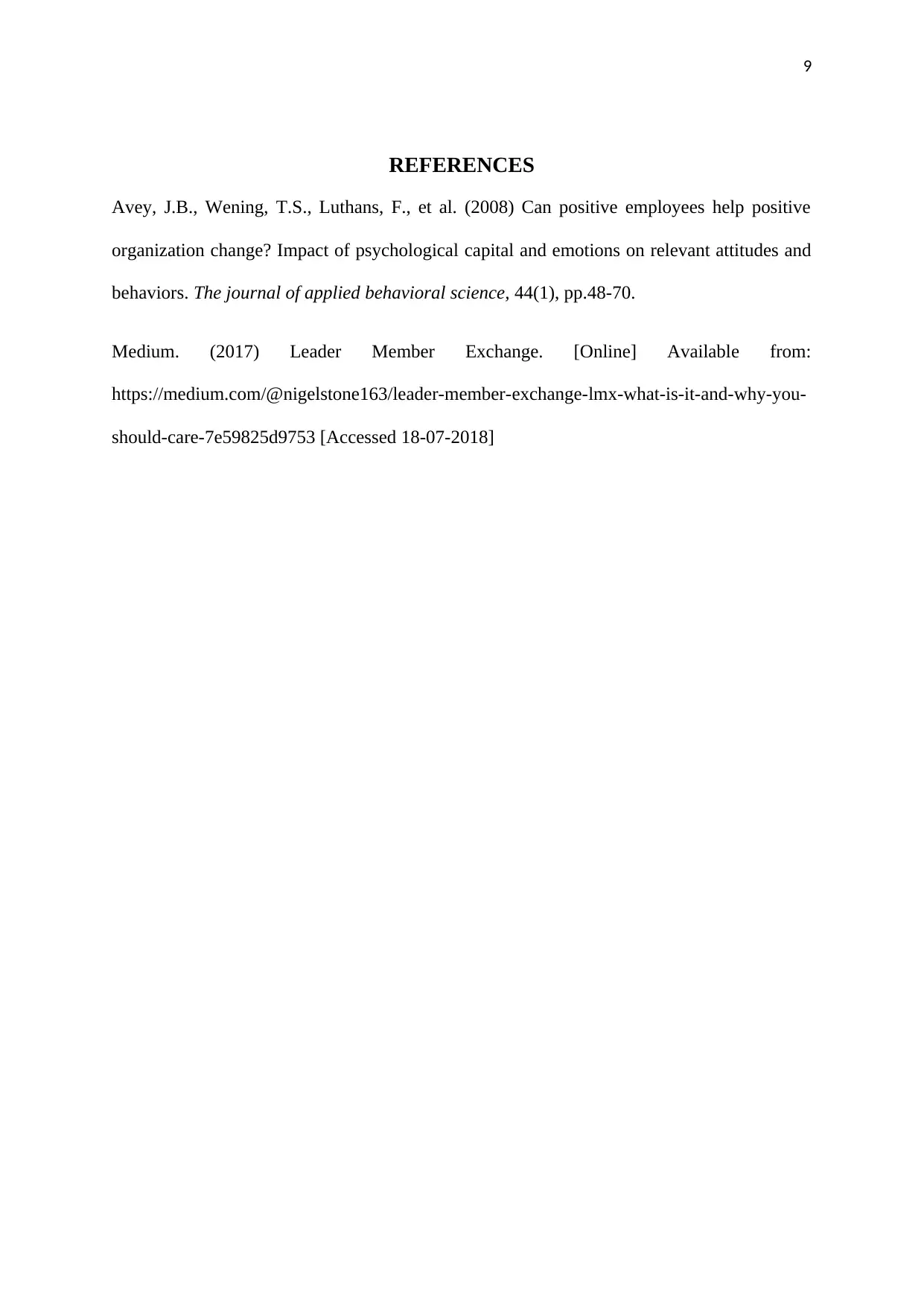
9
REFERENCES
Avey, J.B., Wening, T.S., Luthans, F., et al. (2008) Can positive employees help positive
organization change? Impact of psychological capital and emotions on relevant attitudes and
behaviors. The journal of applied behavioral science, 44(1), pp.48-70.
Medium. (2017) Leader Member Exchange. [Online] Available from:
https://medium.com/@nigelstone163/leader-member-exchange-lmx-what-is-it-and-why-you-
should-care-7e59825d9753 [Accessed 18-07-2018]
REFERENCES
Avey, J.B., Wening, T.S., Luthans, F., et al. (2008) Can positive employees help positive
organization change? Impact of psychological capital and emotions on relevant attitudes and
behaviors. The journal of applied behavioral science, 44(1), pp.48-70.
Medium. (2017) Leader Member Exchange. [Online] Available from:
https://medium.com/@nigelstone163/leader-member-exchange-lmx-what-is-it-and-why-you-
should-care-7e59825d9753 [Accessed 18-07-2018]
Paraphrase This Document
Need a fresh take? Get an instant paraphrase of this document with our AI Paraphraser

10

11
⊘ This is a preview!⊘
Do you want full access?
Subscribe today to unlock all pages.

Trusted by 1+ million students worldwide
1 out of 12
Related Documents
Your All-in-One AI-Powered Toolkit for Academic Success.
+13062052269
info@desklib.com
Available 24*7 on WhatsApp / Email
![[object Object]](/_next/static/media/star-bottom.7253800d.svg)
Unlock your academic potential
Copyright © 2020–2025 A2Z Services. All Rights Reserved. Developed and managed by ZUCOL.




